|
Because positive reinforcement based training often uses food as one of the primary reinforcers when working with our animals, I often hear a couple concerns from owners: 1) "My dog is going to get fat." 2) "My dog had an upset stomach from too many treats in class." We definitely don't want our dogs getting ill or unhealthy, but that doesn't mean we can't use food wisely, and can't in fact have a high rate of reinforcement in our training sessions. How Small is Small? The first thing I notice when students show up to class with their bags of treats is that even though we stress "small, soft, and tasty," people might not realize just HOW small we mean. Below is an example of a popular training treat that we use a lot. The treats are advertised to be used in training and are only 3 calories per treat; nevertheless, they are still way too big in my opinion. Every week, Lowell or I sets aside a few minutes to chop a bag of these treats into quarters: By doing this, a bag goes much further in our multi-dog household, which is good for the budget as well as the dogs' waistlines. Here is another example - on the left are 18 treats chopped up from 3 treats of the same type on the right. Here is an example of a training session with my puppy Royal, working on marking and rewarding offered eye contact. Royal is rewarded nine times in about 27 seconds here for giving me eye contact, and is already starting to build a strong behavior as he immediately looks at me after eating each reward. Royal gets reinforced nine times, but has only actually eaten about 1 1/2 of the treats pictured above. I could have given him twice as much food in only three repetitions had I not broken them up, and I wouldn't be nearly as far along to building a strong behavior, as he would have only been reinforced a third as many times. Value Judgments When our dogs are working hard, I like to pay them well, but the reality is most skills are first built and strengthened in low-distraction settings. In those settings, my dog may work eagerly for a lower value reward, allowing me to save the best stuff for the toughest work. If I am training at home or in a low-distraction environment, I often can use my dog's kibble for most of the rewards. Nowadays most of our dogs eat a home-prepared diet, but when a new dog joins the family, I might keep them on a high quality kibble for a while, allowing me to use their daily calories to help them learn new basic skills (I find this especially helpful for beginning loose leash walking, where I want to be able to reinforce a lot). I have even bought the "small bites" versions of the food I'm feeding in order to pack even more rewards per cup. If the kibble needs a little more punch added, store it in a plastic bag with some small pieces of higher value rewards mixed in (such as hot dog pieces, chicken, cheese, etc.). The kibble will absorb some of that odor and taste, and every now and then your dog will get a bonus when you pull out one of the pieces of high value treats. Can Your Dog Stomach It? On the topic of high value treats, remember that these also should be SMALL, and used wisely. Hot dogs and cheese are popular choices, but I tend to prefer lean boiled chicken or turkey breast. It can be torn into VERY tiny pieces, dogs usually do back flips for it, and unless your dog has a particular sensitivity to that protein, it tends to be bland and easily digested (in fact, veterinarians often recommend boiled chicken breast and rice as a bland diet option for a dog with digestive upset). Choose Quality There are a lot of options out there these days. Treats with a lot of additives, by-products, and preservatives might be cheaper, but they are generally less likely to agree with your dog's system. Even though the higher-end treats might be more expensive, if you are using small pieces you will be spending less and keeping your dog healthier. What About Those Kongs? Like all trainers, we love Kongs, and our dogs get them just about daily. You will find lots of yummy recipe suggestions on-line recommending stuffing them with peanut butter, cream cheese, and other rich foods. While we love the power of peanut butter and cheese when we need it, we use it sparingly and most of our Kongs are stuffed with healthy components of their regular diet. Many of our dogs eat raw, so their dinner is frozen into a large Kong (or similar enrichment toy) that they get every night. If a particular dog is on a commercial diet, I can replace some of their kibble with canned food stuffed in the Kong. For special treats, I might stuff some with other healthy foods that they enjoy, such as non-fat yogurt, banana, sweet potato, and pumpkin, with maybe some canned salmon pieces blended in. Can You Really Blame the Training? OK, overweight pets are an epidemic in our country. But you know what? I don't think you are really training your dog that much. I love training my pets, but I simply don't have the time in the day to give them enough training sessions that it would seriously impact their weight that significantly. If your furry friend is losing his or her figure, it might be time to evaluate how much you are pouring into that food bowl every day. Let your dog's waist be your guide to how much is right for them, not necessarily the back of the food bag. This is my 10-year old Jack Russell terrier, Tempo. He is at his ideal weight of 13 lbs, and is lean, athletic, and well-muscled. He is small, so we are limited in how many calories he can take in in a day, plus he has chronic stomach issues that could be easily exacerbated by too much rich food. Nonetheless, he manages to get regular training and enrichment without any negative effect to his health or physique. All our dogs are in this condition. It can be done! It Isn't All About the Food
Food is great for training, but don't forget there are other rewards also. A throw of the ball, a game of tug, the chance to go for a walk or a swim - all these and more can reinforce behavior as well. Don't forget to build some variety into your reward systems too! Have you found a great, healthy training treat for your dog? Let us know in the comments! Some of us like the cold... And some of us don't... It's hard to be cooped up (just ask our chickens), and so we want to give you all some ideas of things you can do to keep your dogs physically and mentally stimulated when going outside doesn't feel like an option. In this series we'll be covering indoor exercise and enrichment options. This post focuses on the favorite indoor exercise of the Jack Russell terrier above: Walking on the treadmill. He seems to really enjoy it and he's much calmer when he's had some treadmill time. Here's a short video to show you our training process how much fun our guy has on it. Enjoy and stay warm! As we head off for a mini-vacation with the entire family tomorrow, I've been taking care of everyone but Fate while she and Angela have been off at a training seminar. It's kind of a full time job for one person to take care of 6 dogs, 3 cats, 2 parrots, 2 chickens and a rat, so I eliminated almost all of my daily appointments and non household responsibilities to focus on doing just that. That doesn't mean we didn't have fun and get some good socialization and enrichment in. Here are some highlights: DeliveryOn the first night, we ordered pizza. Ok, maybe I took empty boxes and filled them with their dinners, but either way, they found it exciting. Border to Border Ice Cream HikeMaebe, Royal and I walked a section of a local trail and ended the trip at Dairy Queen where they each got their own bowl of vanilla with biscuits. They each thought the other had the better bowl. Downtown ShoppingRoyal and I headed downtown. He had a series of firsts including first parking garage, first elevator, first greeting of a person with a disability. We did some shopping at a local gift shop. Royal was particularly into greeting people during the trip. Sparkle's Secret Swimming Hole And Chuck-it FieldSpark and I went on an outing to a special place with a lot of space and a lot of privacy to swim and fetch. Standy By Me Moment With MaebeMaebe and I walked along the railroad tracks to look for a body that someone had found. Just kidding. To the left of the "wall" behind us is a path that leads to one of our favorite trail systems. Feeding TimeThis is what it looks like (less Fate's dish) at dinnertime. Normally Angela does this. One of many reasons I'll be glad for her to be back. Actually, it's very rewarding to take care of everyone. I sure have missed Angela and Fate. Looking forward to our "real vacation" starting tomorrow. Stay tuned! - Lowell
I have not been good about keeping up with the blogging about our new puppy, mostly because I have been busy trying to keep up with the puppy. Puppies keep you busy!! So, I am long overdue for an update on Royal. Royal is continuing to be wonderful. He is now almost four months old, so we have continued to focus our efforts primarily on raising a confident, well-adjusted puppy. Obedience and sports dog training come second right now, as those skills are all much easier to teach if we have a dog that feels comfortable and safe in the world. So, we have continued giving him positive outings, with the focus always being on quality, and ensuring that all interactions are good ones. Perhaps the most important social relationships for him to develop have been the ones with the rest of our extended multi-species household, especially our other six dogs. We want their relationships to get off to a good start so that we aren't having to undo any damage; therefore, we took our time gradually introducing him. Because Royal was only a little over four pounds when we got him, we also took care to make sure he wasn't injured in any way by a bigger dog. First introductions with five of the six dogs were done with Royal in an exercise pen. Dogs were brought in over the course of the first day, one by one, and allowed to investigate each other through the pen. Both puppy and adults had a handler with them (Lowell and myself) and we were feeding them great treats as they checked each other out. We then let Royal interact first in the living room with each dog, and then in the yard. We took care to introduce Royal to dogs in the order that would best build his confidence, starting from the easiest to get along with, to the hardest. First he met 16-year old border collie Django, who really had zero interest in a puppy and ignored him altogether. Next he met our female border collie, Fate. Fate tends to be completely disinterested in most other dogs as well, but she had a litter earlier in life, so interestingly she was a bit taken with Royal and protective of him in early days (puppy license has since worn off a bit!). Maebe, our 11-year old female BC/terrier mix was next. Maebe tends to initially want nothing to do with young puppies, so in the first days we made interactions extremely brief and rewarded her for tolerating his attentions. After that initial phase, Maebe becomes the best "auntie" dog you'd ever want, and she since has been his patient and willing playmate and Royal adores her. Cadence, our male border collie, is likewise quite patient and tolerant, if not quite as playful. Sparkle, our two-year old Aussie, was second-to-last to meet him. Spark can be unsure during initial meetings, but is generally dog-social once she knows they are OK, and she seemed quite intrigued by this young little thing. Royal has had less off-leash interaction with Spark than the border collies so far, primarily because Spark plays like a brute and doesn't know her own power, so we are careful that she doesn't accidentally hurt him. She has been self-handicapping for the most part, and varies between being willing to play and ignoring him. The major challenge in full integration was introducing Royal to our other Jack Russell Terrier, Tempo. Tempo came to us being extremely reactive to other dogs, but has made a lot of progress and has been able to make several dog friends. Still, he does need slow, careful introductions. I also didn't want to have Tempo go over threshold and react at Royal, as I didn't want Royal to have any negative dog experiences in his early socialization. So, patience was the key, and this was a several-week process. We began with me holding Royal in the yard and Tempo on leash, but this was too close still for Tempo. So, in early days, we would take a daily outing to the park on the corner and sit on opposite sides of a field - me playing with Royal, and Lowell heavily reinforcing Tempo for keeping his cool. Each day we gradually got closer. Eventually we were able to come back into the yard, with Royal in an exercise pen, and Tempo able to approach and sniff. Tempo could tolerate this for very short intervals, but needed frequent breaks. After a few more weeks, we let Tempo approach Royal in his living room ex-pen, and were pleased to see Tempo could now acknowledge him, but go about his business and ignore him too. Finally, we very carefully let them off leash together for short intervals. This video shows one of their first encounters, and the body language I find very interesting to watch. They aren't 100% sure about each other, so the play is a continual dialogue that I translate as each one asking "Is this OK?" Note the frequent pauses - play usually only takes place for a couple seconds at a time before they stop, look away, back up, play bow, etc. before resuming again. They are doing a nice job of managing their own arousal (not Tempo's strong suit previously!). Since this is such progress on Tempo's part, we keep the sessions short, so we don't risk him getting overwhelmed and getting tempted to tell the puppy off. For his part, Royal is doing a nice job skillfully engaging with his older brother who, admittedly, isn't the best at this. No doubt, a happy integration, especially into a complicated household with lots of members with differing personalities, is a LOT of work. Until Tempo got to this point, it meant a lot of careful management and rotating access to different parts of the house for a while. Putting work in up front though is a lot easier than repairing damage from hasty intros gone poorly. I also would not have brought a puppy into this house if Tempo's behavioral issues had not gotten so much better this year - I had twice already refused a puppy because the timing would have been bad during Tempo's struggles last year.
When bringing a puppy into a multi-dog household, take your time and set both dogs up for success. Have a plan for how introductions will happen, and have a management strategy to keep all animals comfortable until they are fully safe and at ease in each other's presence. Don't rush or force things. If either animal is getting stressed, take a break and use crates, ex pens, and baby gates to give each animal their own zone when needed. And make interactions positive ones! Good things should happen in each other's presence. Of course, dogs are only one of the species living in our house. In future posts, we can discuss bringing a puppy into a home with cats, chickens, parrots, and a rat! For now, nap time is probably about over, so I'm off to entertain a puppy! In our puppy classes, we spend our last week playing "puppy agility" - basically having the puppies walk on and through various surfaces. Not only is this usually a lot of fun, but I believe it is good for pups in a couple ways. First, it helps them build confidence on different surfaces, things that move or are unsteady, and things that might make noise. Second, it starts to build body awareness and coordination. We hope Royal will grow up to be a performance dog in agility and other sports, so it is important for those sports that he knows how to use his body. But even if your puppy isn't planning on a dog sports future, coordination, confidence, and an awareness of all four feet is an important skill to develop. We have had numerous owners approach us with dogs that are afraid to walk on the wood or linoleum floors in their new house, or simply can not figure out how to negotiate a flight of stairs. The confidence to do these types of tasks comes from knowing how to use their body, and that is a skill we can teach. We daily try to have Royal practice walking in or on something new, starting with a somewhat unsteady surface with a novel texture: Building up to more unsteady surfaces, that also make noise: And challenges to build his body awareness and confidence. In this exercise, you notice that Royal has to figure out this challenge and it isn't always easy for him. He is allowed to stop and can choose to start over without pressure. Letting him problem solve at his pace and work through something new helps him be resilient, and the next time around he aces the prior problem spot. Because he is growing and his muscles and bones are developing, we are careful not to do high impact activities or to have him jumping higher than his elbows right now. We don't ask for numerous repetitions of the same thing, but let him mostly self-direct his own exercise. Because I like having dogs that enjoy to swim - it is good fitness, a good way to cool down on a hot run, and I find it fun to play around in the water with them - we are also working daily on getting Royal to enjoy water. We first rewarded him for getting in and out of an empty wading pool, until he loved charging in there to make good treats happen. Then every day we began adding a bit more water. He makes the choice to get in, but since we have built a lot of value for the pool by associating it with good things, he hops in and out multiple times a day. He currently is getting in and out of water about elbow deep. Outings this week included going into town, hanging out at a cafe and a winery, visiting dog friendly stores, meeting his "grandparents," and meeting lots of new strangers. He continues to take all his new adventures in stride!
We are two weeks in with puppy Royal today, and are having a blast with him! This little guy is so fun and happy, and just loves to learn and play and interact with us. We are spending a lot of time just hanging out and playing and keeping that desire to interact strong. Right now our training is focused on building cooperation in the things we will have to ask of him throughout life (getting his harness on, being crated, being picked up, grooming, etc.). The most important thing we can do for our puppies at this age is prepare them for "life with humans" and all the weird things that entails. As much as possible, we want his active participation and choice in these things. In times when I have to take choice away, such as picking him up when necessary (he's a tiny thing with developing joints so sometimes it is a fact of life for him right now), we give him fair warning with a cue telling him what to expect (we use "Coming Up" to tell him he will be lifted). This way life still is predictable for him, and therefore still feels safe. One of the first foundations skills we have been working on is shaping him to put his head into a harness. Our first session is below, and while I have sloppy mechanics and even put the harness on upside down at one point, he is engaged and not shying away. I am presenting the harness for him to put his head through, not coming into his space and shoving it over his head. We also have been working on shaping Royal to enter the crate on his own, and building good associations with being in it. Here Lowell is marking any time Royal orients or moves towards the crate in any way. He places the reward closer to and then inside of the crate AFTER Royal has made some effort to move towards it, even if slight at first. Royal receives reinforcement for remaining in the crate. He is free to leave if he wants, but then quickly chooses to move back towards the crate where good stuff happens. Getting him to love that crate and actively wanting to be in it makes building duration in it easy work. The first skill that Royal is learning is hand targeting. This training started on his first day home, and is such an easy and useful behavior. I tell all my students that this is one of the most important thing I train. Hand targeting allows me to ask Royal to move or change position without the need of physical prompting or force. This can be a foundation for teaching a recall, loose leash walking, or position changes. I use this behavior frequently at the vet clinic and when grooming, and if I ever need to smoothly move my dog out of a situation. This guy is so fun to train, and has already figured out that offering behaviors can result in good stuff. He has great stamina for such a young guy, and loves to learn!
Royal's new experiences this week included visiting a pet supply store and strip mall, meeting more new people, seeing different moving objects such as shopping carts, walkers, and kick scooters, passing dogs of different breeds and meeting two friendly Elkhounds owned by a friend, visiting a friend's house, and hearing shotgun fire. We have also been playing tug games while playing a variety of sounds using the Sound Proof Puppy app on our phone, in order to build good associations with obnoxious noises. This week looks to be a hot one, so we'll be looking for cool ways to socialize the pup, plus it looks like we might have the chance to do some conditioning with actual thunderstorms in the next few days. Visiting family will give even more opportunity for meeting friendly people as well. These early weeks are lots of work, but so precious and fleeting - we are enjoying every moment of them and not taking it for granted!  Here at Harmony Dog Training we are excited to announce a new addition to our canine family. After having "puppy fever" for the last year and a half, on Monday, May 29, Lowell and I happily picked up a new youngster! Royal is a male Jack Russell terrier born on March 26, and we are so excited to start our adventures with him. It has been almost exactly eight years since we last had a puppy in the house, so we have decided to document our puppy raising on the blog, to show the types of things we do to prepare our pup for his life with us. We hope you will enjoy reading along with this new adventure! The priority for week one was to integrate him into the household, start developing good habits with housetraining and crate training, begin teaching some foundation skills, but - most importantly - giving him good, safe exposure to a variety of people, places, animals, and experiences. Royal is in the midst of his critical socialization phase right now where he will be making his first impressions about what is safe and unsafe, and what he likes and doesn't like. It is our priority right now to make sure those early impressions are good ones. I always stress the importance of quality even over quantity when talking about socialization, so the key to all his new outings and interactions is that they are always feeling fun and safe for him. At nine weeks, Royal is also in an age range known as a "fear period" where he may be more cautious than normal, and bad experiences at this time could have a very lasting impact that would be hard to undo into adulthood. So, we want to be especially careful during this next week to make sure all experiences are good ones. Socialization is not just meeting people and dogs, but being exposed to all types of sights, sounds, surfaces, and experiences. In our first week together, here are a few of the things Royal has experienced: -Rest areas on the way home with trucks, cars, people, and dogs. -A "healthy puppy" check up at his regular vet. Royal was not yet due for a booster vaccine, so we took advantage of the opportunity to have a needle-free experience with nothing but love from the staff, treats, and tug toy games in the exam room. -A couple trips to the park on the corner, getting used to walking on a leash and harness for short distances. -Walking on grass, concrete, asphalt, wood mulch, gravel, dirt, boardwalk, carpet, tile, linoleum, and epoxied cement flooring. -Standing on a dock over water, an elevated wooden stage, climbing onto metal bleachers, climbing on wooden steps on playground equipment, balancing on inflatable exercise equipment. -Borrowing from Kathy Sdao's concept of "take out meals," he ate dinner at the local canoe livery and watched boats and tubers come and go. -Watching an aid station get set up at a 5K race. Seeing balloons. -Seeing all manner of vehicle traffic, from garbage trucks to police cars to bicycles. Watching pedestrians including walkers, runners, and dogs being walked. -Safe introductions to multiple humans of different ages (including one closely supervised toddler), genders, and races. -Introductions to friendly, appropriate dogs owned by us or our friends. Interactions may include play, but he also practices walking calmly among other dogs, and being able to focus and learn in their presence. -Hearing sounds of trains, garbage trucks, sirens, and a helicopter overhead. -Sharing space with other species including parrots, cats, and chickens. -Having someone else (who he had met) come to the house and take him out to play for a mid-morning break. With all of these experiences, I am being careful to let Royal make the choice of when and whether to interact, investigate, or take in information. When people greet him, I ask them to pause and wait for Royal to come to them (he happily does), and I make sure he has the freedom to move away again if he wanted to. Teaching Royal that he has a choice, and that he will not be forced into scary interactions, will help preserve his confidence and help him continue to be a social dog. I do not lure him onto new surfaces or into interactions, but will reward him with play, treats, and/or letting him know what a super brave wonderful puppy he is. Right now, Royal does genuinely find us fussing over him to be highly reinforcing, but I also know that some situations will and do necessitate higher level rewards, and will not be stingy with them in this important learning phase. It is interesting to see the world through the eyes of a puppy again, and to think about all the things we encounter each day that are brand new experiences for him. Royal is proving to be a confident, thoughtful puppy. If he observes something new that he doesn't yet know how to process, he might pause and take in information for a moment, and then bounds forward enthusiastically. I've been delighted with how he is adapting to this big new world of his. Stay tuned for future posts about Royal's early learning! We are excited to document this exciting time with our little guy! The best laid schemes of mice and men go often askew... - Robert Burns Sparkle and I have returned from a trip that was epic, but not quite as planned. She was an amazing trail warrior for conditions that were significantly harder than we had imagined due to cold, wet weather and beaver activity that created lots of flooding. Still, we accomplished much, completing about 3/4 of the mileage, starting out in Wanakena, traveling counter-clockwise, making it as far as Brandy Brook. On our final day, we covered about 20 miles so that I could get us close to an exit point if need be. A turn in the weather from cold to colder and wetter when we were already soaked meant an early end. I was prepared for that possibility and was able to call in help when needed. The body handling work that I did came in handy as I did have to move her around to position her under an emergency blanket and then into the back of a ranger's ATV for our trip out. Highlights of the trip included surviving a narrow, wobbly, 50 foot log crossing over hip deep water, making camp in a lean-to with some aging hippies while Sparkle dug holes and played with a tennis ball she found, and spending an entire day in a motel room afterwards sleeping (each in our own beds), recovering before the trip back home. Unfortunately, all of our pictures were lost during our evacuation, but we're happy to be safe. SuccessesAs a result of the training process and the trip, Sparkle and I have a stronger relationship. She is better at being handled and at traveling. She is more physically fit. She was able to warm up to strangers on the trail after initial caution and even played fetch with one! I now have a plan of the next things to work on, which are around helping her respond to sudden environmental changes. Hopefully, I have given people food for thought about some of the things involved in a trip like this and that you have enjoyed following our journey, however short it ended up being. Thank you. - Lowell and Sparkle
“Once a journey is designed, equipped, and put in process, a new factor enters and takes over. A trip, a safari, an exploration, is an entity, different from all other journeys. It has personality, temperament, individuality, uniqueness. A journey is a person in itself; no two are alike. And all plans, safeguards, policing, and coercion are fruitless. We find after years of struggle that we do not take a trip; a trip takes us. Tour masters, schedules, reservations, brass-bound and inevitable, dash themselves to wreckage on the personality of the trip. Only when this is recognized can the blown-in-the glass bum relax and go along with it. Only then do the frustrations fall away. In this a journey is like marriage. The certain way to be wrong is to think you control it.” ― John Steinbeck, Travels with Charley: In Search of America Friends, the time has come. Bags are packed and our adventure is about to begin. See you in about a week. - Lowell and Sparkle
"Your problem is to bridge the gap which exists between where you are now and the goal you intend to reach." - Earl Nightengale
I was glad I had taught her directional cues (she'll go left when i say "left", etc.), as there were a number of sharp turns or spots where there was more than one way over the rocks, but some preferable to others. I'll have to show how I trained that as I hadn't thought about how handy that would be as I had taught that skill more for canicross, which is essentially running with your dog with them attached to you and pulling. It was the first time that I could not find the summit marker upon reaching the top of a mountain, but according to my altimeter, we did make it. The trail widens past an antenna and structure and we could have gone many miles (to Georgia, in fact), but we had to get to Stamford by afternoon, so after a mile or so further, we headed back. On the way back we took a left from a split in the trail and went down the fire road that runs more or less parallel to the AT. It is an easier grade, but you miss out on some views. Right before we got back the trailhead, we took a left at a side trail that leads to Table Rock and past that to a steep descent to the far side of Lake Lenape before taking you back to the parking lot for the trailhead. We hiked about 6 miles that morning. It was a nice break from the 550 miles of driving we had done the day before. Up to this point, I think my training has been paying off. Sparkle was the most relaxed she's been on a long car ride. She did well in the cabin and on the trails. The pack fit Sparkle well and she didn't seem to mind carrying it. She didn't chafe and her paws held out, even though it was pretty rocky. We didn't see any people or any dogs the entire 3 hours on the trail, so we really felt like we had what I understand to be a busy trail to ourselves. I feel like I achieved my goal of seeing where we were with taking a long road trip, how she'll settle down for the night in a strange place, how she'll handle the pack, and how she'll hold up on the trail. Feeling good about tackling the CL50 in just a few short weeks. Here's a video compilation of the trip. Enjoy! |
AuthorAngela and Lowell, your friendly Harmony Dog Trainers! Archives
January 2018
Categories
All
|


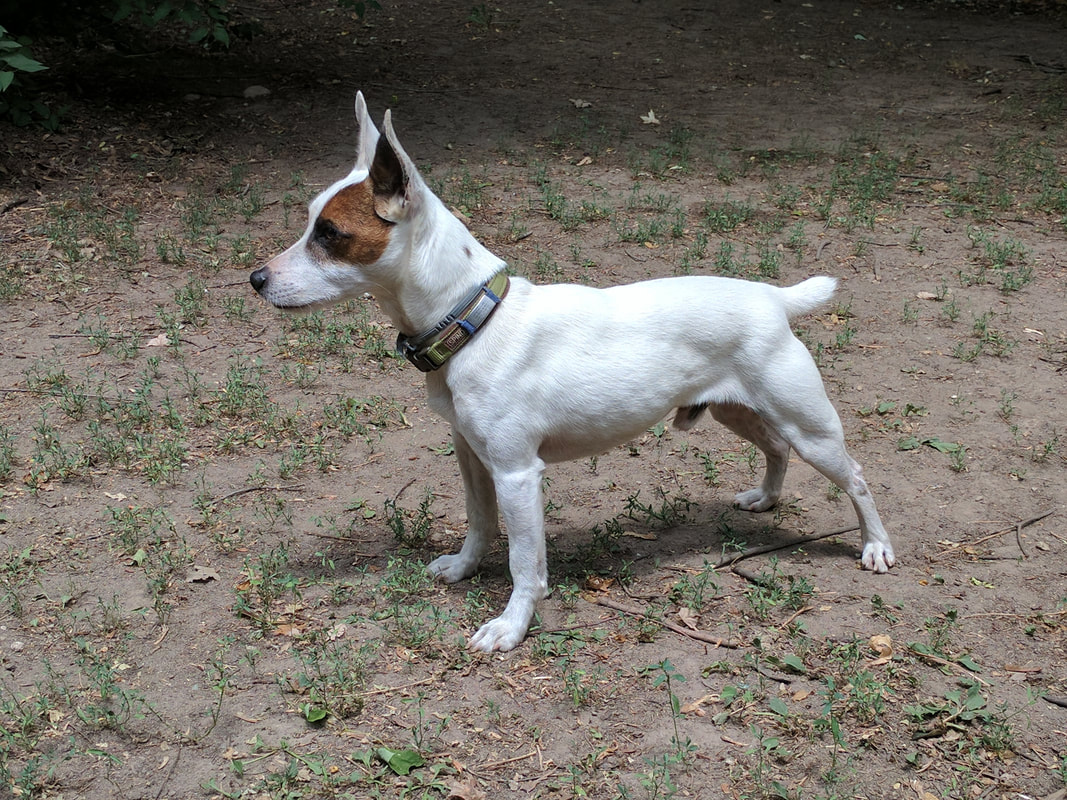




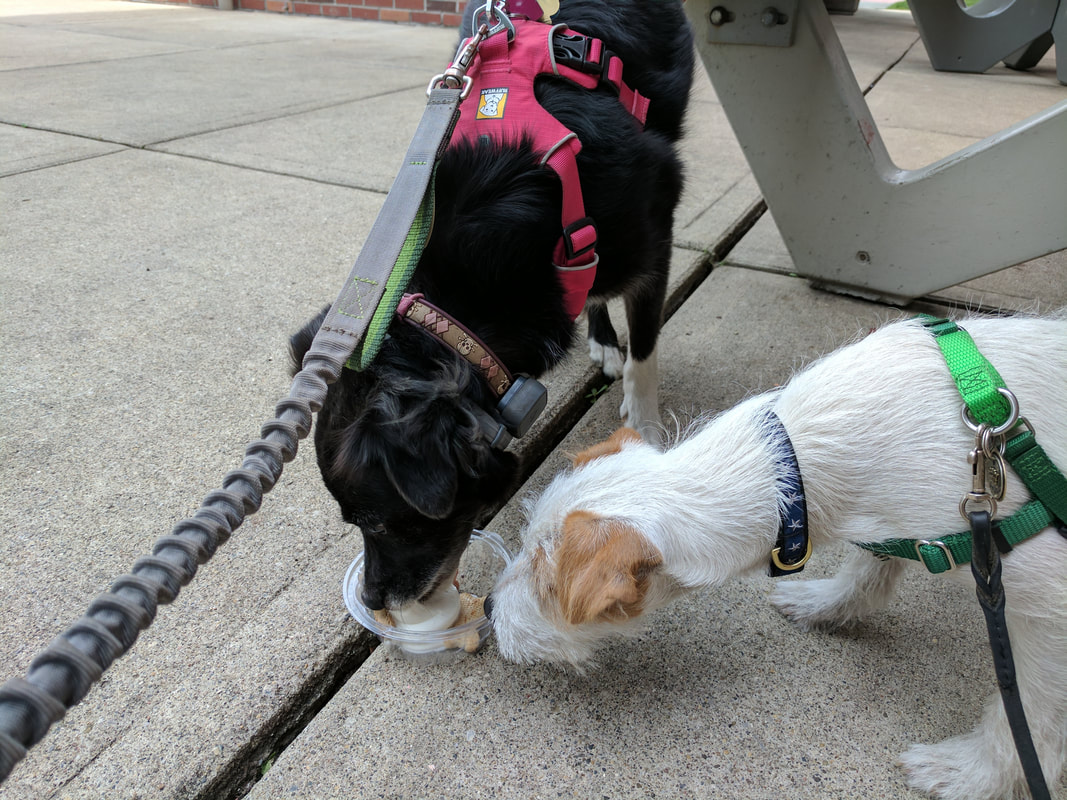



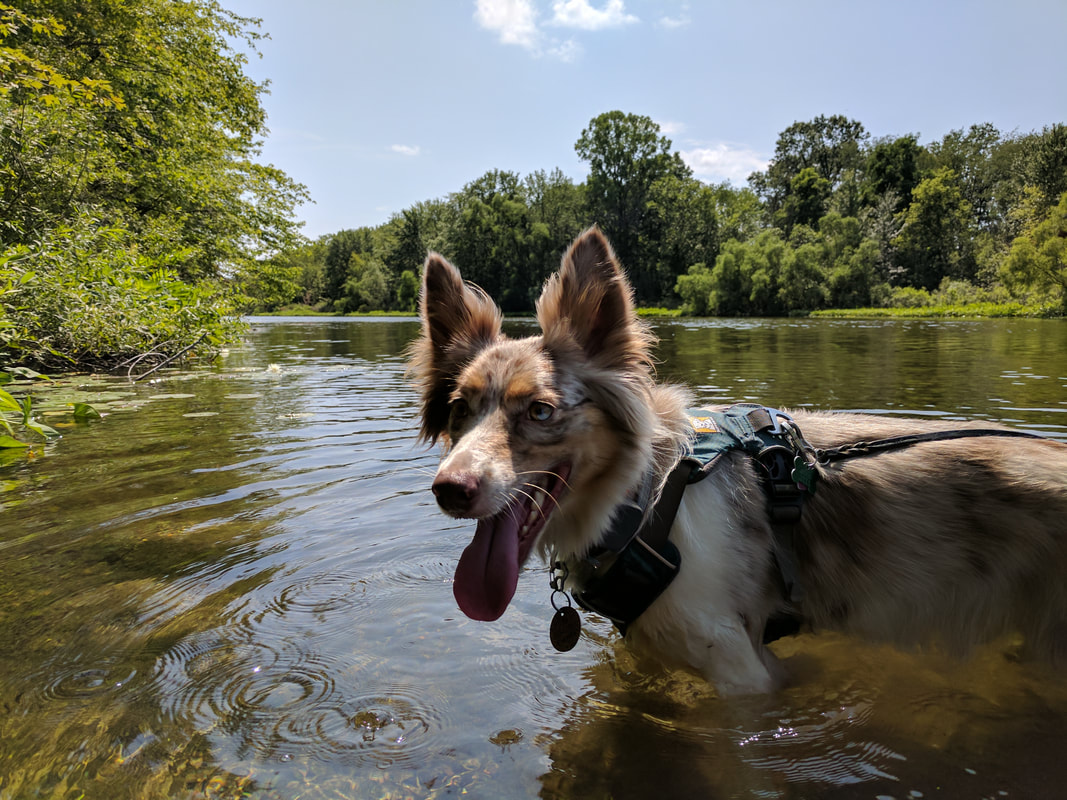
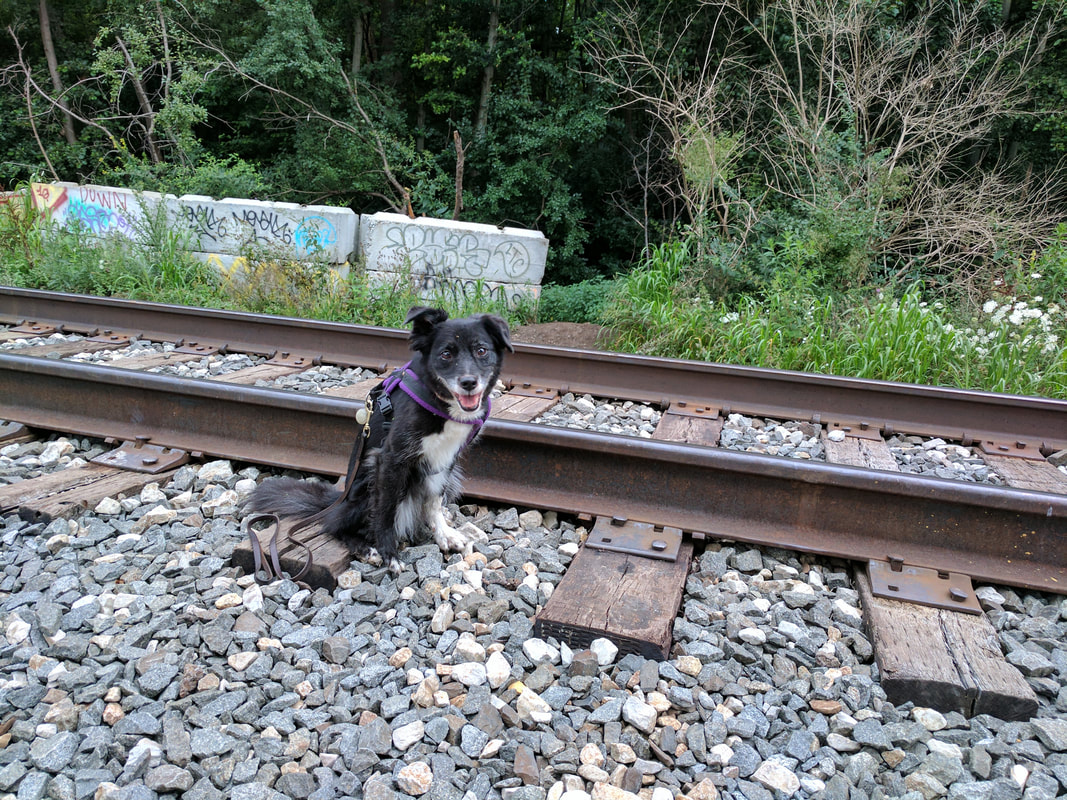
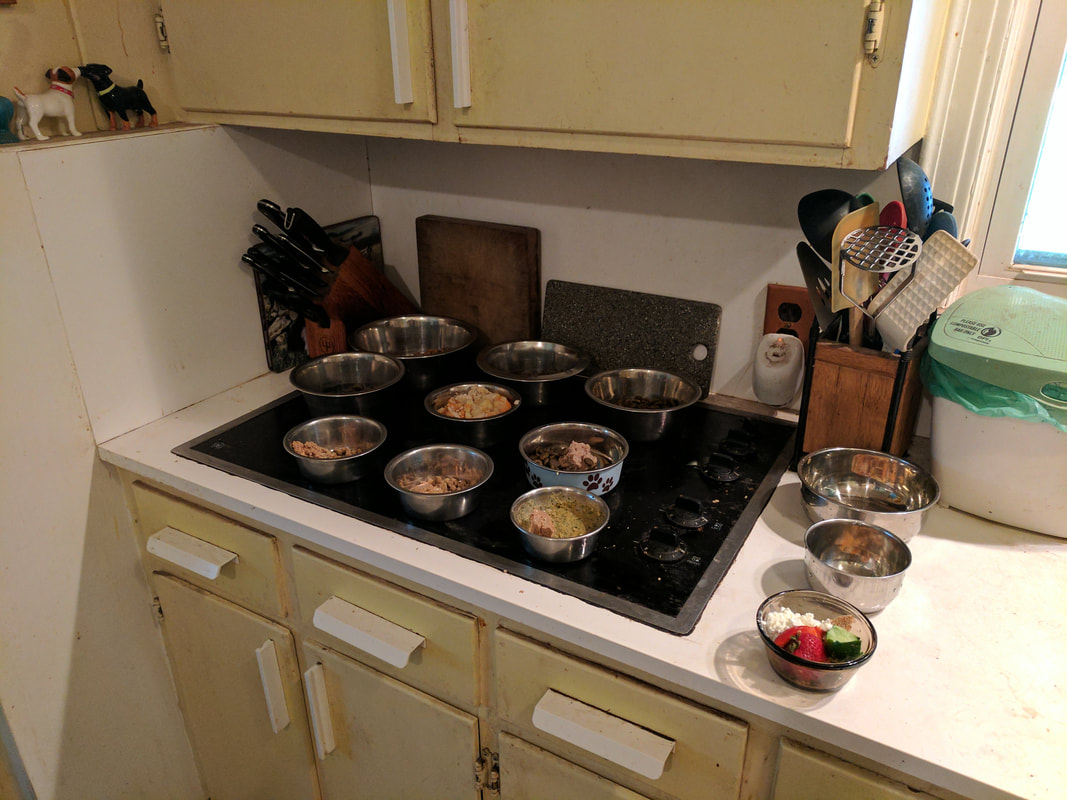


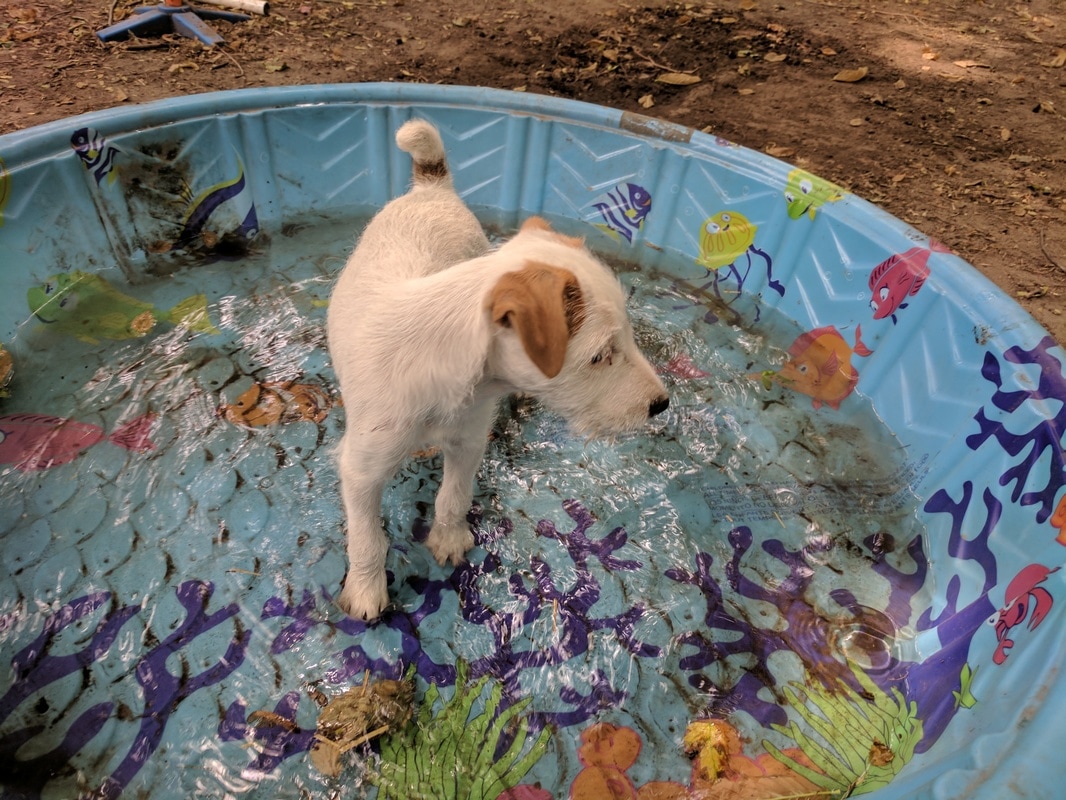








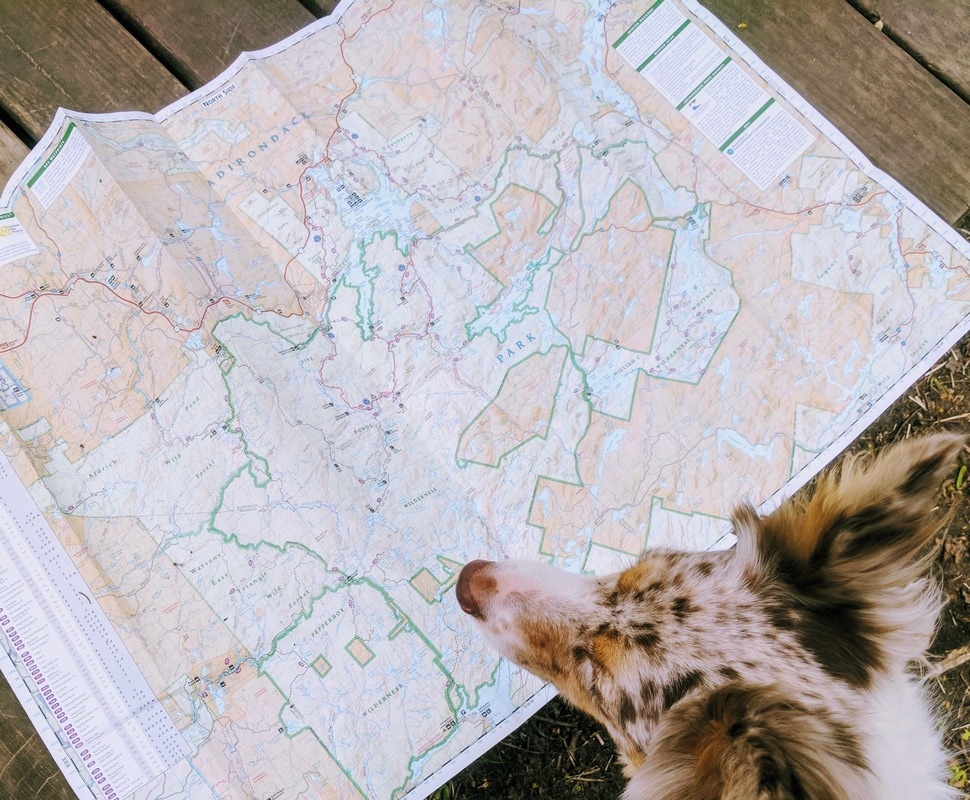



 RSS Feed
RSS Feed